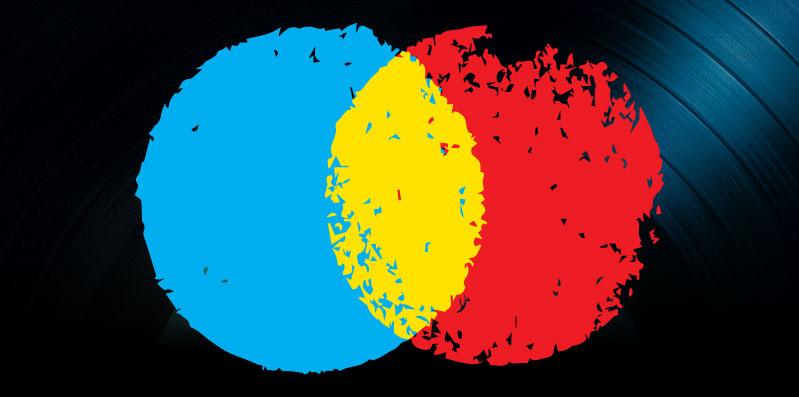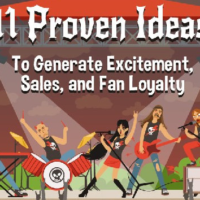
The Future of New Music Business Models
Tom Silverman is the founder and head of TommyBoy Entertainment. Throughout his amazing career Tom has worked with and broken artists like De La Soul, Digital Underground, House of Pain, Queen Latifah and Afrika Bambaataa. In addition Tom helped revive the New Music Seminar and is now one of its principal executives. He’s been kind enough to allow me to feature his candid thoughts about the changing music industry on the Musician Coaching site on several occasions. In January of this year, he shared some insights about what he termed “The Music Business Resurrection.”

As we gear up for the 2012 New Music Seminar in June, Tom talked to me about some of the ideas that will be shared at this year’s event. He also expressed his views on what artists, labels, publishers, technologists and everyone else involved in the industry should be doing if they want to grow and continue to find new and profitable opportunities.
Musician Coaching:
Thanks so much for taking some time, once again, to chat with me, Tom. What’s in store this year for everyone at the New Music Seminar?
TS:
The seminar has taken a big turn to taking a leadership role in driving vision for the music business and returning control of the conversation back to the creators. Technologists have controlled the conversation for at least five years now, and most of the conferences that exist now are sponsored by the technology companies. This one is sponsored by mostly creative companies, like SoundExchange. It’s actually the first SoundExchange Digital Broadcasting Summit. Last year, SoundExchange collected over $350 million and distributed it to labels and artists equally. It has become one of the biggest new sources of revenue for labels and artists in America. This year, the amount of money collected will be well over $400 million. So, we’re approaching half-a-billion dollars in digital broadcasting revenue. And that’s SiriusXM, CBS Interactive, Music Choice, iHeartRadio, all the webcasters. There are so many different people that contribute to that. But the biggest ones are Pandora and SiriusXM, though there are many more, and it’s a growing area as radio listening shifts from FM to online and smartphones.
BMI and SESAC are also sponsoring the Seminar, representing songwriters and the creative community. And there is a bigger emphasis on songwriters and publishers at this conference than at any of the past conferences. It’s much more business oriented, because the problems that are affecting the artists at the artist level have their root in the economics of the music business. And until the economics of the music business change, the lot of the artists themselves won’t change very much. We’re exploring all the new ways the business can start to be profitable again and trying to set new goals for what’s possible for the music business.
Musician Coaching:
And you, personally have an interesting world view. What does the new music business look like, in your opinion?
TS:
Well, I’ve done a little research using the RIAA gross sales numbers at retail, and they say that the music business is about $7 billion in America. But when you look at what labels get at net and remove the cost of goods sold and mechanical so everything is apples to apples, you’re really looking at about a $4-bilion business in America, which isn’t that big. In 1999, that number was double that, or more – somewhere between $8 and $9 billion, which is $14 billion at wholesale. And the world business was supposedly around $37 billion using the IFPI numbers. Now it’s down to around $17-$20 billion. And the U.S. share of that has declined from, at one point, 40 percent of that to now 25 percent or less.
What those numbers are indicating is that we have a lot of things that are changing. And I think we have to look at the business in a new way so we can expand what the business is and reach numbers we couldn’t reach before. When I say the economics of the business are upside down, I mean the risk that investors in music – and for the most part, the investors are labels – are taking is not commensurate with the return on that investment. When you have a high-risk investment, you expect a high reward. And unfortunately the reward for the winners – the people that invest in people like Adele, etc. – is not high enough to justify the losses and the risks they take on the others.
It’s a very difficult business considering its high risk level . Every time you sign an artist, there’s a huge chance that artist will fail. You have to look at it as more of a venture capital business. And with a venture capitalist business, you have high risk, but you also have high return. If you invested $100,000 in Instagram, everyone could do the math and find out what it meant when it got sold a few weeks ago. That’s not happening when you hit with someone like Adele. You’ve invested millions, and then when it sells 20-million units – and when that’s the only one of its kind in over a decade that’s done those kind of numbers – what’s the return on that? And then, often the artist comes back and says, “I want to renegotiate. I don’t want the same deal going forward” in spite of their contract. When a venture capitalist makes a deal, the venturer can’t go back to the venture capitalist and say, “I want to redo the deal.” But that’s what happens in our business. And the contracts only last for six or seven years, while the venture capital contracts last longer than that and cover everything, not just records.
You have to look at that and say, “How can we make this business more interesting to investors and drive money into the music business again that will trickle down to artists? How can we get more people to invest in artist development so that more artists will be able to grow and create music?” I think we’re starting to see how that can happen. And it’s not necessarily going to be tied to record sales. We’re all caught up in record sales, and people still talk about “the record business.” But at the New Music Seminar we strike the word “record” from it and replace it with “music.”
Musician Coaching:
I do remember that the first incarnation of the re-launched New Music Seminar I went to was very tech heavy. It was MySpace Music and TuneCore, which was a relatively new company. It was all these people providing technological solutions to age-old problems, and, in my opinion, there really was this overture of, “Anybody can do this now. The barrier to entry has been removed.” But that didn’t pan out.
If you’re doing something that’s more publisher and songwriter oriented, which topics of conversation are going to be the ones most in debate? What are you hoping your average musician will come away with this year?
TS:
We used to have 10-12 panels in the old days. We now have 22, and 20 intensives – the lectures and keynotes – on top of that. Plus, we’re doing a music festival for the first time, which will have about 150 artists performing in over 15 venues. All of that is new. The scope and the expanse of what we’re trying to do is double or triple of what we’ve ever tried to do before, both in terms of the music performances and the speakers. We’ll have 150 people speaking this time, and everyone’s focus will be on business.
And the focus won’t all be on songwriters, because really we’re increasing the total number of movements we have by three times. So, we’re adding a lot of new movements to the ones we have had before. There will still be A&R, producers and artists movements. But we’re also going to go beyond that. For example, we have one on video innovators – artists that are breaking through YouTube. And that’s a good example of what we talked about at the first seminar. But it didn’t really start to happen in full force until last year, when Mac Miller entered at #1 with only 27 spins at radio. Benji Grinberg will talk about how Rostrum Records has been able to be successful and sell over 140,000 units the first week for an artist with only 27 spins at radio, but over 30-million views on YouTube.
There are a lot of new methods to generate revenue now that didn’t exist even a year or two ago. The monetization of YouTube, getting the CPM up, advertisers investing in the Web and that money trickling down to artists and their investors is a new area.
Musician Coaching:
Let me ask you some hot questions around that. There’s an issue with Vevo now, and it has a lot to do with branding. Artists will come to me and ask, “How do I get on Vevo?” And it’s usually through the distributor. But every time I read about how that splits, there seems to be a publishing question mark there. Do you have any first-hand experience with that? Do you think Vevo is actually helping artists break?
TS:
Vevo is a way to drive the monetization of YouTube up higher. And I think Vevo was very important in showing people you can get more than $10 CPM for music instead of $2, which is what the CPM was pre Vevo. They also spend a lot of time educating brands and advertising agencies on how that can all happen. And now Google is doing a much better job selling advertising as well.
So, I think what Vevo’s done has been really great for the business and will eventually trickle down and be great for artists. The majority of the stuff is the big stuff right now. And that’s not where these developing artists are making money. Mac Miller, Hoodie Allen – the most recent success – and Alex Day in the UK, who was #4 during Christmas week, were not Vevo artists. So, it’s not Vevo where artists are breaking. But it is Vevo that helped drive the revenue up. Alex Day makes more money from his ad share for his video views on YouTube than he makes from selling music – or at least as much. We’re seeing that trending in many places. And we’re going to see the revenue that artists are making off their share of plays increase. That’s promising.
But that’s not the answer I’m talking about. That’s not going to take our $4- or $7-billion business back to what it was in 1999, where they claimed it was $14.5 billion at retail. I’m looking for it to be $30 billion. How do we get it there when we’re sitting at $7 billion? How do we quadruple the music business in terms of dollars? The way that’s going to happen is through models more like Cricket, where the Cricket offering is one that doesn’t generate Spotify-sized monthly revenue on a per-person basis to the artist, but it taps into the passive music buyer.
The number I’ve heard recently is that there are about 200-million music buyers in the world. And there are about seven-billion people in the world. So, if we can make that 200 million grow to 250 million, we can make a little bit more money. But that would only take the net world music business from $16 billion to $20 billion. It won’t take it back to its peak in 1999. It will just make it a little bigger. If we can get the people who are buying music to buy more music, maybe we can push it a little further than that. And if we can get them to spend a little more money, we might be able to take it even further than that.
But none of this will take us to a 100-billion-dollar worldwide business. The only way we’ll get there is by finding a way to monetize passives. Because, the passives outnumber music buyers – there are six billion passives vs. 200 million music buyers. There are six-billion activated cell phones in the world. And there are 1.2-billion smartphones activated now, which means smartphones that are actively being used, with active subscriptions that have been paid for. The trend everywhere is moving towards smartphones. The entire world is going to open up to that level of accessing music.
Cricket will have most of their phones within the next three or four years, include music as part of their offerings. You’ll get unlimited downloads to your phones as part of your subscription. You don’t have to pay or opt-in. So, if you want a song, you can get it. Of course, you can only get it on your phone and can’t do anything with it. That’s why it’s less expensive, and they only pay us less than three dollars a month for that subscription out of the $55 charge. That amount will add up. And there will be theoretically 10-, to 30-million people that might have phones in America that have music as part of them. But they won’t even feel like they’re paying for the music, because it will be so inexpensive that it will feel like free. But they will have access. And some people won’t use it at all, some people might download two or three songs, others might download a million. It doesn’t matter. We’ll be generating revenue from all of them, which will be new revenue for the music business.
Musician Coaching:
You mentioned there are about 250-million music purchasers out there.
TS:
The number I heard was 200 million. But I’d say it’s between 200 and 250 million. It’s a hard number to pin down, but no one thinks it’s higher than that. And I’m referring to people that have ever bought music in the last decade, worldwide.
Musician Coaching:
What’s daunting to me is that by my calculations – and I’ve been doing research on this as I’ve been preparing for my own talk at New Music Seminar – there are about 63-million musicians in the United States alone. Roughly one in five people are musicians. And this is based on the U.S. Census and a study NAMM did on the number of musicians per household. Mind you, it’s really next to impossible to calculate how many of those people are aspiring vs. how many of them are professional.
TS:
And I think those numbers include anyone who owns a musical instrument. For example, I have guitars but don’t play guitar anymore, so I would fall into that category.
Musician Coaching:
Yes. Clearly, those are people that own musical instruments too. Even if the number is a tenth of that, those are kind of long odds.
TS:
So, assume those are the people that buy music. What if those were the only people in America who buy music? Say 60-, 70- or maybe even 80-million people buy music, and another 120-million people around the music buy music. That’s your number right there. The rest are happy with the radio or just listen to whatever they hear around them.
I think that we in the music business are so passionate about music that we assume that everyone is as passionate as we are and has similar music-buying habits. But I don’t think that’s the case. If you want to step back far enough and help this business become a $100-billion business, you have to activate 3- or 4-billion people, even if it’s only at $1 per month. And then you’ll generate an extra $36 billion on top of $15 or $20 billion that’s there, and you’ll be in a $50- or $60-billion business, which compared to what we’re in now is four-times bigger.
The way the music business can really tap into significant revenues is going to be through mobile phone providers. That needs to be a big priority for us in the industry: How do we expand the business by working with mobile phone companies to create systems that work for them and also work for us? I’m not saying that’s going to be easy, because dealing with publishers and labels never is. But there needs to be leadership on the label side trying to drive that.
Musician Coaching:
Do you think the label system is prepared for that kind of seismic shift?
TS:
Big time. More than ever before in our history. If you were going to tell somebody at Universal or Warner Bros., “I could make your catalog be worth three-times as much in 10 years, what’s that worth to you?”
They’d say, “What do I have to do?” If that means hiring specialists to work phone companies and mobile service providers in every territory in the world the way they work radio stations to get records on the air, that might be a good investment in the future. Or maybe that’s something that RIAA should be involved in. I’m not sure. Or maybe that’s something for the IFPI, instead of 100-percent protectionism. How can we grow the business?
SiriusXM has 22-million subscriptions. And if it wasn’t for Detroit, they probably wouldn’t have a million or two million. It’s the car companies that are driving SiriusXM subscriptions. They understand that. We need to understand that as a business, we have to find a way to attach music to other things that can generate revenue for us that we’re not getting right now and monetize music much more fully than having to have sales be the sole driver, which is really a limiting factor.
Musician Coaching:
I have a couple questions. Spotify is a hot-button issue right now with a lot of people because royalty statements have been disappointing to artists.
TS:
Why are they disappointing? You’ve probably talked to a lot of artists about this, but I just don’t understand why artists feel any differently about Spotify revenues than they feel about CD sales or track downloads on iTunes. Why are these any different from any other kind of revenue they’ve gotten in the past?
Musician Coaching:
I guess a lot of artists are still married to the old model. I can’t speak to exactly why. But most artists I speak to through my site and otherwise seem disappointed by what they’re getting per play. And maybe that’s silly.
TS:
Are they getting more per play when they get played on FM radio? They don’t get anything from FM radio, because FM radio in America doesn’t pay any artists. Anything they get from a streaming service – even if it’s a penny – is better than what they get from a play on a traditional radio station. So, finally all that SoundExchange money we’ve talked about is new revenue that is coming from digital broadcasters. If all broadcasting was digital broadcasting, that could be billions of dollars in new money.
You only have 500,000 – 600,000 subscribers – and we don’t know the exact numbers – on Spotify. It doesn’t have a million subscribers yet in America, so the revenues are going to still be small. But when that number gets big enough – somewhere between 11 and 15 million – the amount they collect should be about the same they receive from iTunes in America.
But if this is done through a label and the artist’s balance is unrecouped, that money is going to go against their unrecouped balance, and they won’t see it, just like they don’t see their money from CD or iTunes now. If an artist is in an unrecouped position, they won’t get paid no matter what happens. Because the investor has to get their money back before the artist can make money.
That’s what I don’t understand. No artist has been able to articulate to me what the problem is or where they see an issue. How is money from Spotify or any other subscription service different from money that comes from iTunes or from WalMart? They get their 15-percent of all of it after the investor gets recouped. So, they’re getting their percentage of the pie at the same level as they’re getting it everywhere else, except it’s based on streaming.
Musician Coaching:
It’s interesting when you look at it alongside what we’ve talked about with the future of the music business. What you’re really talking about is not only growing the business in terms of selling more music, but also growing the businesses and platforms that could be the delivery mechanisms for music in the future, such as mobile phone providers, car manufacturers, streaming music services, etc. That seems to be the evolving trend of the music business.
TS:
I think that’s one trend. Another is monetizing attention. One of the things we’ve learned from Instagram, Facebook, Google and everything like that is that we’re in an attention-based economy: Attention equals dollars now. If you look at the attention that’s garnered by the artists and music that the labels control, it seems like there should be a better way to monetize that attention. Labels are so focused on selling albums and secondarily, music, that they aren’t really focused on monetizing the attention and focus that those artists and that music create. If they created relationships with artists where they would manage and monetize the relationships artists have with fans and the impressions the artists and their music create in the world, the value of that would probably be 10-50-times greater than just selling records.
For details about the upcoming seminar , which takes place June 17-19 in New York City, visit the official New Music Seminar website. If you haven’t already signed up, you can get a 20% discount by using the code NMSNYMC2348 at registration.
Also, stay tuned for more thoughts from Tom Silverman in the coming weeks.





